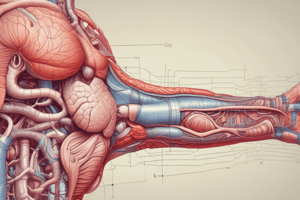Podcast
Questions and Answers
What is the primary function of the salivary glands in the digestion process?
What is the primary function of the salivary glands in the digestion process?
- Storing bile
- Regulating defecation
- Lubricating and moistening food (correct)
- Secretion of pancreatic juice
Which enzyme initiates the carbohydrate digestion in the mouth?
Which enzyme initiates the carbohydrate digestion in the mouth?
- Lipase
- Trypsin
- Pepsin
- Amylase (correct)
What is the primary function of the gallbladder in the digestion process?
What is the primary function of the gallbladder in the digestion process?
- Synthesizing bile
- Storing and regulating bile secretion (correct)
- Regulating defecation
- Releasing pancreatic juice
Which accessory organ is responsible for synthesizing bile?
Which accessory organ is responsible for synthesizing bile?
What is the primary function of the anal columns and sphincters in the digestion process?
What is the primary function of the anal columns and sphincters in the digestion process?
What is the primary function of lacteals in the digestive system?
What is the primary function of lacteals in the digestive system?
Where does mechanical digestion of food take place?
Where does mechanical digestion of food take place?
What is the name of the tube that connects the mouth and esophagus?
What is the name of the tube that connects the mouth and esophagus?
How many teeth do humans have?
How many teeth do humans have?
What type of nutrients are transported by capillaries?
What type of nutrients are transported by capillaries?
What is the primary site of chemical digestion in the mouth?
What is the primary site of chemical digestion in the mouth?
What is the main function of amylase released by the pancreas?
What is the main function of amylase released by the pancreas?
In which part of the ruminant digestive system does the final digestion take place?
In which part of the ruminant digestive system does the final digestion take place?
What is the role of the pyloric cecum in the fish digestive system?
What is the role of the pyloric cecum in the fish digestive system?
What is the function of the proventriculus in the avian digestive system?
What is the function of the proventriculus in the avian digestive system?
Which of the following is responsible for fat digestion?
Which of the following is responsible for fat digestion?
What is the function of the omasum in the ruminant digestive system?
What is the function of the omasum in the ruminant digestive system?
Flashcards are hidden until you start studying
Study Notes
Digestive System
- The anal columns and sphincters help regulate defecation.
- Ingestion, digestion, and secretion occur in the digestive system, followed by absorption for transport to other tissues.
Accessory Organs
- Salivary glands (parotid, sublingual, and submandibular) secrete saliva that lubricates and moistens food and contains amylase for carbohydrate digestion.
- The liver synthesizes bile, which is stored and regulated by the gallbladder.
- The pancreas releases pancreatic juice containing amylase, trypsin, and lipase.
Absorption
- Capillaries transport water-soluble nutrients.
- Lacteals are responsible for transporting glycerol and fatty acids.
- The digestive system takes nutrients from digested food for transport to different tissues.
Human Digestive System
- The mouth is a site for both mechanical and chemical digestion.
- The tongue is a muscular organ for tactility and gustation.
- Humans have 32 teeth that physically break down food.
- The pharynx is a tube that connects the mouth and esophagus, with nasopharynx and oropharynx portions.
Enzymes
- Bile is responsible for fat emulsification.
- Amylase is responsible for starch digestion.
- Trypsin is responsible for protein digestion.
- Lipase is responsible for lipid digestion.
- Nuclease performs nucleic acid digestion.
Ruminant Digestive System
- Ruminant ingests food rich in cellulose.
- Mechanical digestion and exposure to cellulase occur in the rumen.
- The reticulum helps in regurgitation of food.
- The omasum performs further mechanical digestion.
- The abomasum performs the final digestion.
Ruminant Animals
- Examples of ruminant animals include hog deer, cattle, camel, and sheep.
Fish Digestive System
- Bony fishes engulf water and trap particles with gill rakers.
- Food moves to the esophagus and stomach.
- The pylorus leads to the pyloric cecum.
- The pancreas secretes proteases, lipases, and carbohydrases.
- Nutrient absorption occurs in the intestines.
Avian Digestive System
- During ingestion, birds do not chew their food.
- Food moves to the crop, where it can still be regurgitated.
- The enzymes of the proventriculus facilitate chemical digestion.
- The gizzard facilitates mechanical digestion of food.
- Food wastes and urine have a common exit point, the cloaca.
Avian Examples
- Examples of birds with unique digestive systems include hummingbirds and penguins.
- Parent birds can store food in their crop for regurgitation upon return to their nests.
Studying That Suits You
Use AI to generate personalized quizzes and flashcards to suit your learning preferences.




